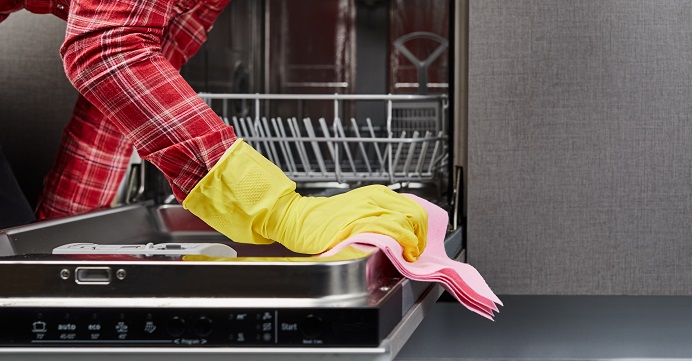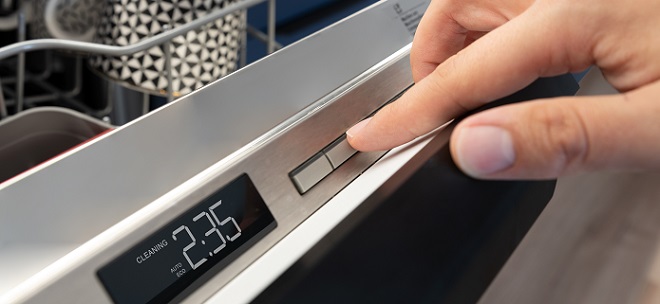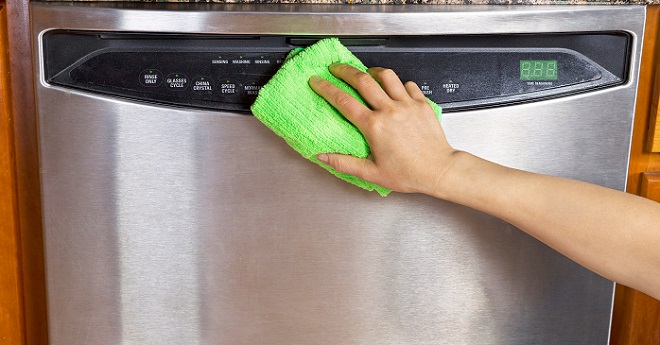How to Clean a Dishwasher: A 2024 Guide to a Fresher Kitchen

Cleaning a dishwasher might not be the first thing on your mind when thinking about kitchen upkeep. You may even think that because soap and water run through it, a dishwasher doesn’t need cleaning. The fact is, your dishwasher is exposed to a lot of food debris, grease, and general gunk. A clean dishwasher is the best way to keep your dishes spotless and extend the appliance's lifespan. Knowing how to clean a dishwasher helps keep it running efficiently and prevents issues like unpleasant odors and buildup.
KEY TAKEAWAYS
- Regular cleaning keeps your dishwasher performing well and prevents unpleasant odors.
- Monthly cleaning with vinegar and baking soda helps remove buildup and maintain efficiency.
- Scheduling annual professional maintenance extends the life of your dishwasher and promotes peak performance.
The Importance of Cleaning Your Dishwasher
The best way to keep your dishwasher in top condition is regular cleaning. Not only does it help maintain a clean appearance, but it also offers several important benefits:
Prevents Odors and Buildup
Food particles and grease can accumulate in a dishwasher over time, leading to unpleasant smells and bacteria growth. Regular cleaning removes these residues, keeping your kitchen fresh and hygienic.
Maintains Optimal Performance
A dishwasher's performance can decline if debris clogs the spray arms or filters. Regular maintenance ensures water flows freely, which helps the dishwasher run efficiently and clean dishes thoroughly.
Extends Appliance Lifespan
Keeping a dishwasher clean helps prevent wear and tear on its components. By reducing buildup and blockages, regular cleaning can prolong the life of your appliance, saving you money on repairs and replacements in the long run.
Gather Your Cleaning Supplies
To effectively clean a dishwasher, gather the following supplies:
Basic Cleaning Supplies
- White vinegar or a dishwasher cleaner: These help break down mineral deposits and sanitize the interior.
- Baking soda: Useful for deodorizing and gently scrubbing away grime.
- Dish soap: A mild detergent for cleaning seals, gaskets, and exterior surfaces.
Tools for Detailed Cleaning
- Soft brush or toothbrush: Perfect for scrubbing small parts and crevices.
- Microfiber cloth or sponge: Ideal for wiping down the interior and exterior without scratching surfaces.
- Toothpicks or bamboo skewers: Handy for clearing out debris from spray arm holes.

Step-by-Step Guide to Cleaning Your Dishwasher
Learning how to clean a dishwasher begins with following a few simple steps. It's an easy task that will pay off with a fresher dishwasher and cleaner dishes.
Remove and Clean the Filter
- Remove the bottom dishrack to access the filter at the bottom of the tub.
- Carefully pull out the filter while being mindful of any sharp objects, such as broken glass, that may be caught in it.
- Rinse the filter under running water to remove food particles and debris.
- Use a soft brush to scrub away any remaining deposits on the filter screen.
- Wipe the filter housing clean with a cloth or sponge before reinstalling the filter.
Clear Deposits from Spray Arm Holes
- Remove the lower spray arm by gently twisting or pulling it off, depending on your dishwasher model.
- Use toothpicks or bamboo skewers to clear out any hard water deposits or detergent residue from the spray arm holes.
- Rinse the spray arm under running water to remove loosened debris.
- Reinstall the spray arm and repeat the process for the upper spray arm.

Wipe Down the Interior
- Use a damp microfiber cloth or sponge to wipe down the interior of the dishwasher, including the door, sides, and bottom.
- Pay extra attention to corners and crevices where food particles and grime may accumulate.
- Clean the detergent dispenser by wiping out any residue. Use a brush if needed to remove stubborn deposits.
Clean the Seals and Gaskets
- Inspect the rubber seals and gaskets around the dishwasher door for any residue or mold.
- Clean them with a mixture of water and mild dish soap.
- Use a soft brush or toothbrush to gently scrub these areas, ensuring all buildup is removed.

Run a Cleaning Cycle
- Place a cup of white vinegar on the top rack of the dishwasher.
- Run a wash cycle on the highest temperature setting to remove mineral deposits, grease, and odors.
- Sprinkle a cup of baking soda on the bottom of the dishwasher.
- Run a second wash cycle to neutralize odors and leave the interior fresh.
Clean the Drain Hose
- Locate the end of the drain hose, which usually connects to the garbage disposal or sink drain.
- Disconnect the hose and clear out any grease and debris that may have built up.
- Reconnect the hose securely to prevent leaks.

Wipe Down the Outer Door Panel
- Wipe the exterior of the dishwasher with a damp cloth, focusing on buttons, handles, and other surfaces where dirt and fingerprints accumulate.
- Use a stainless steel cleaner if your dishwasher has a stainless steel exterior to polish and maintain its shine.
Maintain Your Dishwasher and Home Appliances
Knowing how to clean a dishwasher means understanding how often to do it. Regular monthly cleaning helps keep your dishwasher running smoothly.
Key Dishwasher Maintenance Tips:
- Clean the filter and spray arms regularly to prevent blockages.
- Wipe down the interior and seals to avoid odors and residue buildup.
- Run a cleaning cycle with vinegar and baking soda to remove grime and keep the dishwasher fresh.
For optimal performance and to extend the lifespan of all your appliances, consider scheduling a professional maintenance service once a year. A professional technician can thoroughly inspect and clean your appliance, catching any potential issues early and keeping it in top condition.
If you experience issues with your dishwasher or any other home appliance, don't hesitate to schedule a repair service. Regular maintenance and timely repairs are key to ensuring all your appliances run efficiently and last longer.
Schedule your dishwasher maintenance now!
Regular dishwasher maintenance can help prevent costly breakdowns, reduce energy costs and extend the life of your appliance.
Was this information helpful?
Schedule your dishwasher maintenance now!
Maintain Dishwasher Resources
Learn how to remove filters from your 2025 GE dishwasher in just 3 easy steps!
Get the top 6 expert tips for cleaning your Frigidaire Gallery dishwasher in 2025. Keep your dishwasher sparkling clean with these easy steps!
Looking for answers on how long should a dishwasher last? Sears Home Services has expert advice and tips to help you extend its lifespan.
Discover the top 5 tips on how to clean a Hotpoint dishwasher in 2024. Keep your dishwasher running smoothly with these expert cleaning techniques.
Glossary Terms
Hard water is water that contains high levels of dissolved minerals, particularly calcium and magnesium. It contrasts with soft water, which has lower concentrations of these minerals.
A freezer bag is a specially designed plastic bag used for the cold storage of food in the freezer, offering protection against freezer burn and preserving the food's freshness and flavor over extended periods.
A furnace filter is a component installed in HVAC systems to trap and remove dust, pollen, and other airborne particles from the air, enhancing indoor air quality and protecting the furnace's inner workings.
A garbage disposal is a device installed under a kitchen sink that shreds food waste into small enough pieces to pass through plumbing, facilitating an easier and more hygienic kitchen waste management process.
Common Repair Dishwasher Symptoms
The most common reasons your Whirlpool dishwasher won't wash are a faulty pump and motor assembly, defective electronic control board or a clogged spray arm.
The most common reasons your Whirlpool dishwasher won't start cycle are a defective electronic control board, damaged power supply board or a failed door switch.
The most common reasons your Whirlpool dishwasher won't drain are a failed drain pump, faulty pump and motor assembly or a cracked drain hose.
The most common reasons your Whirlpool dishwasher will not spray water are a faulty circulation pump, a clogged spray arm, or a defective electronic control board.
The most common reasons your Whirlpool dishwasher is not working are a defective electronic control board, damaged user interface control or a stripped wire connector.
The most common reasons your Whirlpool dishwasher is not washing are a faulty pump and motor assembly, defective electronic control board or a clogged spray arm.



